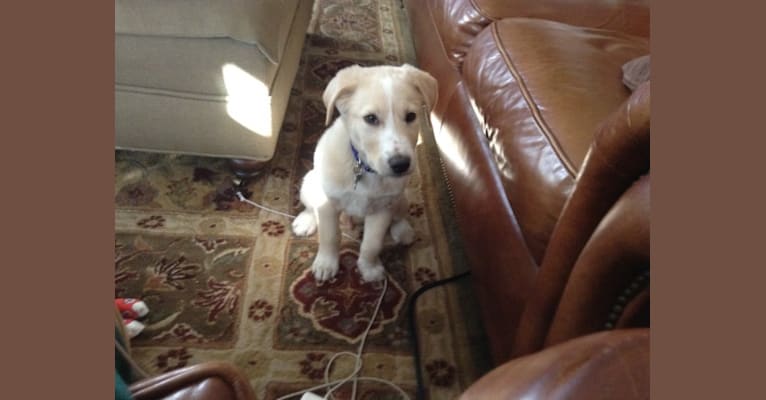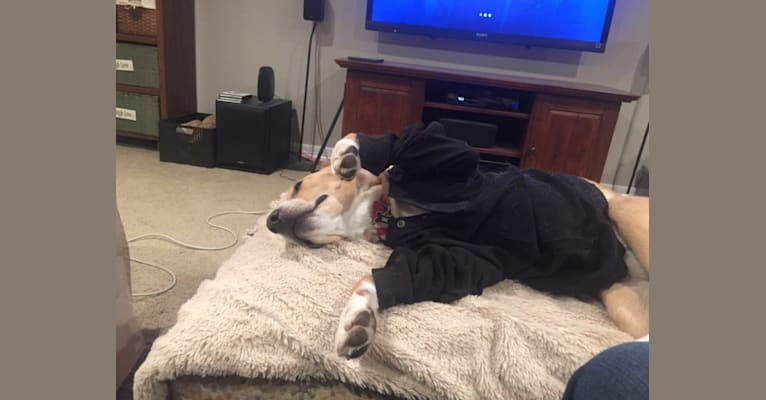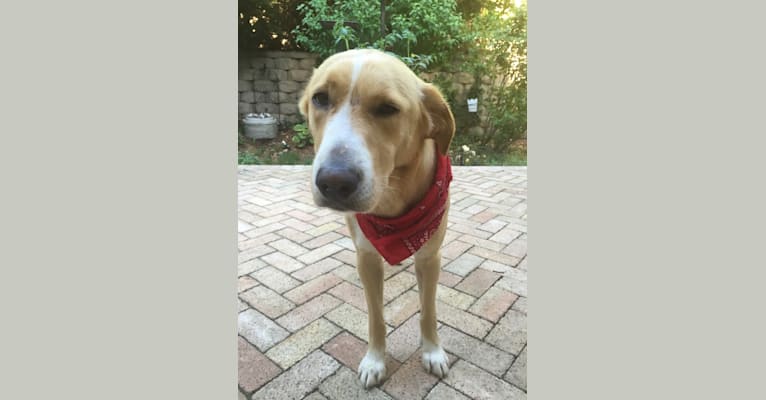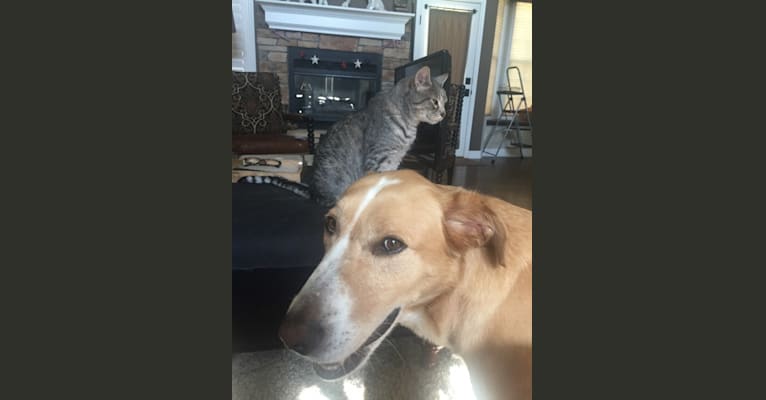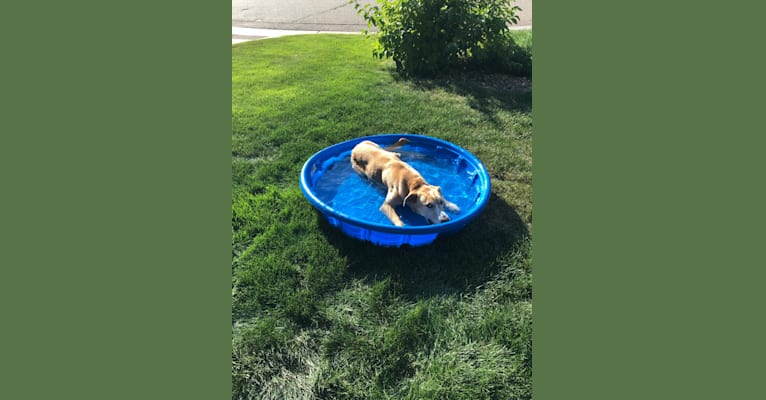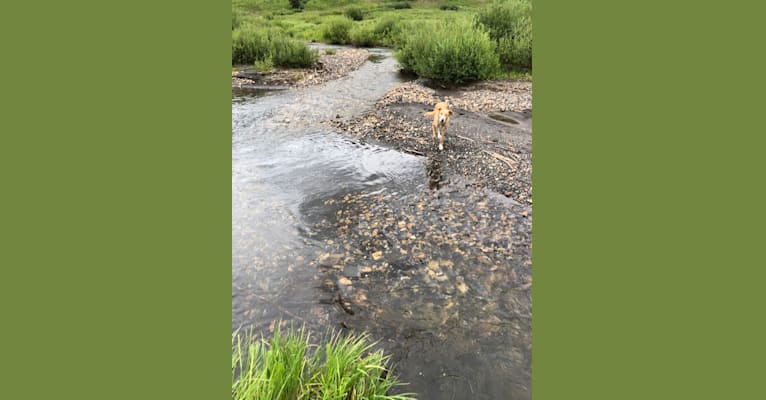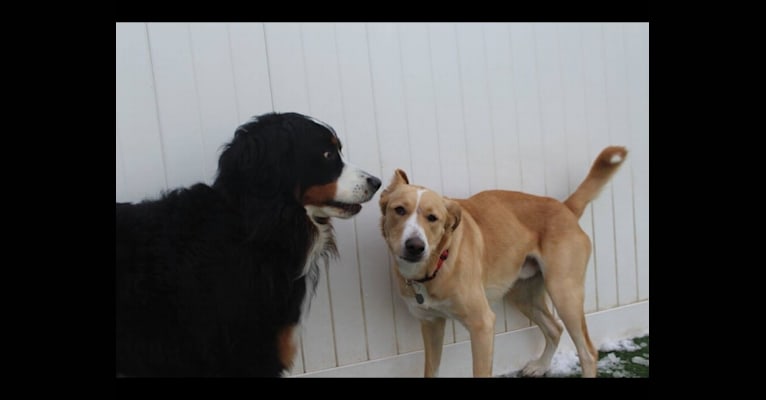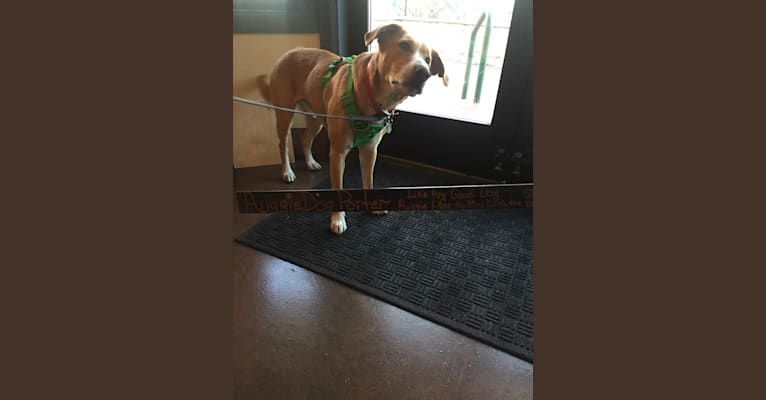Augie inherited one copy of the variant we tested
“Augie loves swimming, hiking and camping. He is from New Mexico and we found him through a rescue group in Ft Collins. He does have discospondylitis caused by the brucella bacteria. He's fine as long as he takes doxycycline twice a day. He had severe spinal pain before we found out what was wrong with him. Apparently, the condition is rare. Just wondering if there are any other dogs, maybe even from New Mexico, who might have the same condition.”
Place of Birth
New Mexico, USA
Current Location
Littleton, Colorado, USA
This dog has been viewed and been given 2 wags
Genetic Breed Result
Augie
Mixed Ancestry
50.0% Labrador Retriever
9.4% Australian Cattle Dog
8.2% German Shepherd Dog
6.7% Collie
6.5% Rottweiler
5.5% Doberman Pinscher
13.7% Supermutt
Embark Supermutt analysis
What’s in that Supermutt? There may be small amounts of DNA from these distant ancestors:

Labrador Retriever
The Labrador Retriever was bred for hunting and excelled in retrieving game after it was shot down. Known for its gentle disposition and loyalty, the Labrador Retriever has become a favorite of families and breeders alike.
Learn More

Australian Cattle Dog
A classic cattle dog, Australian Cattle Dogs were developed from a mixture of breeds in Australia in the 19th century, and still maintain their energetic herding instincts today.
Learn More

German Shepherd Dog
German Shepherds are confident, courageous dogs with a keen sense of smell and notable intelligence. These are active working dogs who excel at many canine sports and tasks -- they are true utility dogs! Their versatility combined with their loyal companionship has them consistently listed as one of the most popular breeds in the United States.
Learn More

Collie
Collies are attractive herding dogs, boasting a beautiful coat while being highly intelligent. They also make for extremely loyal and sweet family pets.
Learn More

Rottweiler
Originally used for driving cattle and protecting valuable convoys, Rottweilers are now popular family pets as well as guard, police and military dogs.
Learn More

Doberman Pinscher
Doberman Pinschers are a strong and athletic breed that are built to guard and protect.
Learn More
Dig into your dog’s mix
From energy to appetite, from herding to health — it’s amazing how much you can learn about your dog with just a cheek swab. What will you find out?
Get your test
Start a conversation! Message this dog’s humans.
Genetic stats
Dogs Like Augie

Discover dogs who share a similar breed mix to Augie. A higher score means the two dogs have more of their breed mix in common. A score of 100% means they share the exact same breed mix!
Click or tap on a pic to learn more about each dog and see an in-depth comparison of their DNA, breeds, and more.
DNA Breed Origins
Explore
Changes to this dog’s profile
- On 2/15/2020 changed name from "August" to "Augie"
Our policy is that each dog’s profile should accurately portray the dog to which the genetic reports belong.
To help ensure adherence to this policy, we show here any changes that have been made to the name or handle (web address) of this dog.
If you believe that this profile is in violation of this policy, you may contact us to report it.
Here’s what Augie’s family tree may have looked like.




























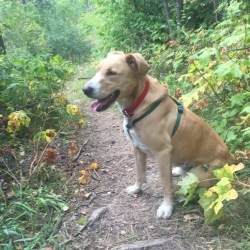

Dig into your dog’s mix
From energy to appetite, from herding to health — it’s amazing how much you can learn about your dog with just a cheek swab. What will you find out?
Get your test
Explore
Health Summary
Augie inherited two variants that you should learn more about.
And one variant that you should tell your vet about.
Progressive Retinal Atrophy, prcd
What does this result mean?
This variant should not impact Augie’s health. This variant is inherited in an autosomal recessive manner, meaning that a dog needs two copies of the variant to show signs of this condition. Augie is unlikely to develop this condition due to this variant because he only has one copy of the variant.
What is Progressive Retinal Atrophy, prcd?
PRA-prcd is a retinal disease that causes progressive, non-painful vision loss. The retina contains cells, called photoreceptors, that collect information about light and send signals to the brain. There are two types of photoreceptors: rods, for night vision and movement, and cones, for day vision and color. This type of PRA leads to early loss of rod cells, leading to night blindness before day blindness.
Exercise-Induced Collapse, EIC
Augie inherited one copy of the variant we tested
What does this result mean?
This variant should not impact Augie’s health. This variant is inherited in an autosomal recessive manner, meaning that a dog needs two copies of the variant to show signs of this condition. Augie is unlikely to develop this condition due to this variant because he only has one copy of the variant.
What is Exercise-Induced Collapse, EIC?
EIC has been linked to a mutation in the DNM1 gene, which codes for the protein dynamin. In the neuron, dynamin trucks neurotransmitter-filled vesicles from the cell body, where they are generated, to the dendrites. It is hypothesized in dogs affected with EIC, the mutation in DNM1 disrupts efficient neurotransmitter release, leading to a cessation in signalling and EIC.
ALT Activity
Augie inherited one copy of the variant we tested
Why is this important to your vet?
Augie has one copy of a variant associated with reduced ALT activity as measured on veterinary blood chemistry panels. Please inform your veterinarian that Augie has this genotype, as ALT is often used as an indicator of liver health and Augie is likely to have a lower than average resting ALT activity. As such, an increase in Augie’s ALT activity could be evidence of liver damage, even if it is within normal limits by standard ALT reference ranges.
What is ALT Activity?
Alanine aminotransferase (ALT) is a clinical tool that can be used by veterinarians to better monitor liver health. This result is not associated with liver disease. ALT is one of several values veterinarians measure on routine blood work to evaluate the liver. It is a naturally occurring enzyme located in liver cells that helps break down protein. When the liver is damaged or inflamed, ALT is released into the bloodstream.
Breed-Relevant Genetic Conditions
Multiple Drug Sensitivity
Identified in Australian Cattle Dogs, Collies, and more
Variant not detected
Hemophilia A
Identified in German Shepherd Dogs
Variant not detected
Hemophilia A
Identified in German Shepherd Dogs
Variant not detected
Von Willebrand Disease Type I, Type I vWD
Identified in Doberman Pinschers
Variant not detected
Canine Leukocyte Adhesion Deficiency Type III, CLAD III
Identified in German Shepherd Dogs
Variant not detected
Canine Elliptocytosis
Identified in Labrador Retrievers
Variant not detected
Pyruvate Kinase Deficiency
Identified in Labrador Retrievers
Variant not detected
Golden Retriever Progressive Retinal Atrophy 2, GR-PRA2
Identified in Labrador Retrievers
Variant not detected
Progressive Retinal Atrophy, crd4/cord1
Identified in Labrador Retrievers
Variant not detected
Collie Eye Anomaly
Identified in Australian Cattle Dogs and Collies
Variant not detected
Day Blindness
Identified in German Shepherd Dogs
Variant not detected
Day Blindness
Identified in Labrador Retrievers
Variant not detected
Primary Lens Luxation
Identified in Australian Cattle Dogs
Variant not detected
Macular Corneal Dystrophy, MCD
Identified in Labrador Retrievers
Variant not detected
Cystinuria Type II-A
Identified in Australian Cattle Dogs
Variant not detected
Urate Kidney & Bladder Stones
Identified in German Shepherd Dogs and Labrador Retrievers
Variant not detected
Anhidrotic Ectodermal Dysplasia
Identified in German Shepherd Dogs
Variant not detected
Renal Cystadenocarcinoma and Nodular Dermatofibrosis
Identified in German Shepherd Dogs
Variant not detected
Mucopolysaccharidosis Type VII, Sly Syndrome, MPS VII
Identified in German Shepherd Dogs
Variant not detected
Neuronal Ceroid Lipofuscinosis 5, NCL 5
Identified in Australian Cattle Dogs
Variant not detected
Neuronal Ceroid Lipofuscinosis 8, NCL 8
Identified in Australian Cattle Dogs
Variant not detected
Deafness and Vestibular Syndrome of Dobermans, DVDob, DINGS
Identified in Doberman Pinschers
Variant not detected
Alexander Disease
Identified in Labrador Retrievers
Variant not detected
Degenerative Myelopathy, DM
Identified in Collies, German Shepherd Dogs, and more
Variant not detected
Narcolepsy
Identified in Labrador Retrievers
Variant not detected
Juvenile Laryngeal Paralysis and Polyneuropathy
Identified in Rottweilers
Variant not detected
Dilated Cardiomyopathy, DCM1
Identified in Doberman Pinschers
Variant not detected
Dilated Cardiomyopathy, DCM2
Identified in Doberman Pinschers
Variant not detected
Centronuclear Myopathy, CNM
Identified in Labrador Retrievers
Variant not detected
Myotonia Congenita
Identified in Australian Cattle Dogs
Variant not detected
X-Linked Myotubular Myopathy
Identified in Labrador Retrievers
Variant not detected
Congenital Myasthenic Syndrome, CMS
Identified in Labrador Retrievers
Variant not detected
Hereditary Nasal Parakeratosis, HNPK
Identified in Labrador Retrievers
Variant not detected
Skeletal Dysplasia 2, SD2
Identified in Labrador Retrievers
Variant not detected
Additional Genetic Conditions
Explore
Traits
Explore the genetics behind your dog’s appearance and size.

Base Coat Color
Genetic Result: ee
Gene: Melanocortin Receptor 1 (MC1R)
This gene helps determine whether a dog can produce dark (black or brown) hairs or lighter yellow or red hairs. Any result except for ee means that the dog can produce dark hairs. An ee result means that the dog does not produce dark hairs and will have lighter yellow or red hairs all over its entire body.
The overall MC1R genetic result is influenced by more subloci than those presented in this section. Additional MC1R subloci results can be found under the Coat Color Modifiers > Facial Fur Pattern section below.
If a dog has an ee result, then the fur’s actual shade can range from a deep copper to white - the exact color cannot be predicted solely from this result and will depend on other genetic factors, including the red pigment intensity test.
More information: http://www.doggenetics.co.uk/masks.html
Genetic Result: Intermediate Red Pigmentation
Intensity refers to the concentration of red pigment in the coat. Dogs with more densely concentrated (intense) pigment will be a deeper red, while dogs with less concentrated (dilute) pigment will be tan, yellow, cream, or white. Five locations in the dog genome explain approximately 70% of red pigmentation intensity variation across all dogs. Because the locations we test may not directly cause differences in red pigmentation intensity, we consider this to be a linkage test.
One of the genes that influences pigment intensity in dogs, TYR, is also responsible for intensity variation in domestic mice, cats, cattle, rabbits, and llamas. In dogs and humans, more genes are involved.
Genetic Result: Bb
Gene: Tyrosinase Related Protein 1 (TYRP1)
This gene helps determine whether a dog produces brown or black pigments. Dogs with a bb result produce brown pigment instead of black in both their hair and skin, while dogs with a Bb or BB result produce black pigment. Dogs that have ee at the E (Extension) Locus and bb at this B (Brown) Locus are likely to have red or cream coats and brown noses, eye rims, and footpads, which is sometimes referred to as "Dudley Nose" in Labrador Retrievers.
“Liver” or “chocolate” is the preferred color term for brown in most breeds; in the Doberman Pinscher it is referred to as “red”.
More information: http://www.doggenetics.co.uk/liver.html
Genetic Result: DD
Gene: Melanophilin (MLPH)
This gene helps determine whether a dog has lighter “diluted” pigment. A dog with a Dd or DD result will not be dilute. A dog with a dd result will have all their black or brown pigment lightened (“diluted”) to gray or light brown, and may lighten red pigment to cream. This affects their fur, skin, and sometimes eye color. The D locus result that we report is determined by three different genetic variants that can work together to cause diluted pigmentation. These are the common d allele, also known as “d1”, and the less common alleles known as “d2” and “d3”. Dogs with two d alleles, regardless of which variant, are typically dilute.
There are many breed-specific names for these dilute colors, such as “blue”, “charcoal”, “fawn”, “silver”, and “Isabella”. Dilute dogs, especially in certain breeds, have a higher incidence of Color Dilution Alopecia which causes hair loss in some patches.
More information: http://www.doggenetics.co.uk/dilutes.html

Coat Color Modifiers
Genetic Result: KBky
Gene: Canine Beta-Defensin 103 (CBD103)
This gene helps determine whether the dog has a black coat. Dogs with a kyky result will show a coat color pattern based on the result they have at the A (Agouti) Locus. A KBKB or KBky result means the dog is dominant black, which overrides the fur pattern that would otherwise be determined by the A (Agouti) Locus. These dogs will usually have solid black or brown coats, or if they have ee at the E (Extension) Locus then red/cream coats, regardless of their result at the A (Agouti) Locus. Dogs who test as KBky may be brindle rather than black or brown.
Even if a dog is “dominant black” several other genes could still impact the dog’s fur and cause other patterns, such as white spotting.
More information: http://www.doggenetics.co.uk/black.htm
Genetic Result: aya
Gene: Agouti Signalling Protein (ASIP)
This gene is responsible for causing different coat patterns. It only affects the fur of dogs that do not have ee at the E (Extension) Locus and do have kyky at the K (Dominant Black) Locus. It controls switching between black and red pigment in hair cells, which means that it can cause a dog to have hairs that have sections of black and sections of red/cream, or hairs with different colors on different parts of the dog’s body. Sable or Fawn dogs have a mostly or entirely red coat with some interspersed black hairs. Agouti or Wolf Sable dogs have red hairs with black tips, mostly on their head and back. Black and tan dogs are mostly black or brown with lighter patches on their cheeks, eyebrows, chest, and legs. Recessive black dogs have solid-colored black or brown coats.
The ASIP gene causes interesting coat patterns in many other species of animals as well as dogs.
More information: http://www.doggenetics.co.uk/tan.html
Genetic Result: ee
Gene: Melanocortin Receptor 1 (MC1R)
This gene determines whether a dog can have dark hair and can give it a black “mask” or “widow’s peak,” unless the dog has overriding coat color genetic factors. Dogs with one or two copies of Em in their result may have a mask, which is dark facial fur as seen in the German Shepherd Dog and Pug. Dogs with no Em in their result but one or two copies of the Eg, Ea, or Eh variants can instead have a "widow's peak", which is dark forehead fur.
The "widow’s peak" is seen in the Afghan Hound and Borzoi, and is called either “grizzle” or “domino.”
In the absence of Em, dogs with the Eg variant can have a “widow’s peak” phenotype. In the absence of both Em and E variants, dogs with the Ea or Eh variants can express the “widow’s peak” phenotype. Additionally, a dog with any combination of two of the Eg, Ea, or Eh variants (example: EgEa) is also expected to express the grizzle phenotype.
More information: http://www.doggenetics.co.uk/masks.html
Genetic Result: NN
Gene: RALY
The "Saddle Tan" pattern causes the black hairs to recede into a "saddle" shape on the back, leaving a tan face, legs, and belly, as a dog ages. The Saddle Tan pattern is characteristic of breeds like the Corgi, Beagle, and German Shepherd. Dogs that have the II genotype at this locus are more likely to be mostly black with tan points on the eyebrows, muzzle, and legs as commonly seen in the Doberman Pinscher and the Rottweiler. This gene modifies the A Locus at allele, so dogs that do not express at are not influenced by this gene.
The Saddle Tan pattern is characteristic of breeds like the Corgi, Beagle, and German Shepherd.
Genetic Result: Ssp
Gene: MITF
This gene is responsible for most of the white spotting observed in dogs. Dogs with a result of spsp will have a nearly white coat or large patches of white in their coat. Dogs with a result of Ssp will have more limited white spotting that is breed-dependent. A result of SS means that a dog likely has no white or minimal white in their coat. The S Locus does not explain all white spotting patterns in dogs and other causes are currently being researched. Some dogs may have small amounts of white on the paws, chest, face, or tail regardless of their result at this gene.
Any dog can have white spotting regardless of coat color. The colored sections of the coat will reflect the dog’s other genetic coat color results.
More information: http://www.doggenetics.co.uk/white.htm
Genetic Result: mm
Gene: PMEL
This gene is responsible for mottled or patchy coat color in some dogs. Dogs with an M*m result are likely to appear merle or could be "non-expressing" merle, meaning that the merle pattern is very subtle or not at all evident in their coat. Dogs with an M*M* result are likely to have merle or double merle coat patterning. Dogs with an mm result are unlikely to have a merle coat pattern.
Merle coat patterning is common to several dog breeds including the Australian Shepherd, Catahoula Leopard Dog, and Shetland Sheepdog.
More information: http://www.doggenetics.co.uk/merle.html
Genetic Result: hh
Gene: PSMB
This gene, along with the M Locus, determines whether a dog will have harlequin patterning. This pattern is recognized in Great Danes and causes dogs to have a white coat with patches of darker pigment. A dog with an Hh result will be harlequin if they are also M*m or M*M* at the M Locus and are not ee at the E locus. Dogs with a result of hh will not be harlequin.
While many harlequin dogs are white with black patches, some dogs have grey, sable, or brindle patches of color, depending on their genotypes at other coat color genes.
More information: http://www.doggenetics.co.uk/harlequin.html

Other Coat Traits
Genetic Result: II
Gene: RSPO2
This gene is responsible for “furnishings”, which is another name for the mustache, beard, and eyebrows that are characteristic of breeds like the Schnauzer, Scottish Terrier, and Wire Haired Dachshund. A dog with an FF or FI result is likely to have furnishings. A dog with an II result will not have furnishings. We measure this result using a linkage test.
In breeds that are expected to have furnishings, dogs without furnishings are the exception - this is sometimes called an “improper coat”.
Genetic Result: ShLh
Gene: FGF5
This gene affects hair length in many species, including cats, dogs, mice, and humans. In dogs, an Lh allele confers a long, silky hair coat across many breeds, including Yorkshire Terriers, Cocker Spaniels, and Golden Retrievers. An ShSh or ShLh result is likely to mean a shorter coat, like in the Boxer or the American Staffordshire Terrier. The coat length determined by FGF5, as reported by us, is influenced by four genetic variants that work together to promote long hair.
The most common of these is the Lh1 variant (G/T, CanFam3.1, chr32, g.4509367) and the less common ones are Lh2 (C/T, CanFam3.1, chr32, g.4528639), Lh3 (16bp deletion, CanFam3.1, chr32, g.4528616), and Lh4 (GG insertion, CanFam3.1, chr32, g.4528621). The FGF5_Lh1 variant is found across many dog breeds. The less common variants, FGF5_Lh2 have been found in the Akita, Samoyed, and Siberian Husky, FGF5_Lh3 have been found in the Eurasier, and FGF5_Lh4 have been found in the Afghan Hound, Eurasier, and French Bulldog.
The Lh alleles have a recessive mode of inheritance, meaning that two copies of the Lh alleles are required to have long hair. The presence of two Lh alleles at any of these FGF5 loci is expected to result in long hair. One copy each of Lh1 and Lh2 have been found in Samoyeds, one copy each of Lh1 and Lh3 have been found in Eurasiers and one copy each of Lh1 and Lh4 have been found in Afghan Hounds and Eurasiers.
In certain breeds, such as Pembroke Welsh Corgi and French Bulldog, the long coat is described as “fluffy.”
Genetic Result: CT
Gene: MC5R
This gene affects how much a dog sheds. Dogs with furnishings or wire-haired coats tend to be low shedders regardless of their result for this gene. In other dogs, a CC or CT result indicates heavy or seasonal shedding, like many Labradors and German Shepherd Dogs. Dogs with a TT result tend to be lighter shedders, like Boxers, Shih Tzus and Chihuahuas.
Genetic Result: CC
Gene: KRT71
For dogs with long fur, dogs with a TT or CT result will likely have a wavy or curly coat like the coat of Poodles and Bichon Frises. Dogs with a CC result will likely have a straight coat—unless the dog has a "Likely Furnished" result for the Furnishings trait, since this can also make the coat more curly.
Dogs with short coats may have straight coats, whatever result they have for this gene.
Genetic Result: NN
Gene: FOXI3
This gene can cause hairlessness over most of the body as well as changes in tooth shape and number. This particular gene occurs in Peruvian Inca Orchid, Xoloitzcuintli (Mexican Hairless), and Chinese Crested; other hairless breeds are due to different genes. Dogs with the NDup result are likely to be hairless while dogs with the NN result are likely to have a normal coat. We measure this result using a linkage test.
The DupDup result has never been observed, suggesting that dogs with that genotype cannot survive to birth.
Genetic Result: NN
Gene: SGK3
This gene is responsible for Hairlessness in the American Hairless Terrier. Dogs with the DD result are likely to be hairless. Dogs with the ND genotype will have a normal coat, but can pass the D variant on to their offspring.
Genetic Result: NN
Gene: SLC45A2
This gene causes oculocutaneous albinism (OCA), also known as Doberman Z Factor Albinism. Dogs with a DD result will have OCA. Effects include severely reduced or absent pigment in the eyes, skin, and hair, and sometimes vision problems due to lack of eye pigment (which helps direct and absorb ambient light) and are prone to sunburn. Dogs with a ND result will not be affected, but can pass the mutation on to their offspring. We measure this result using a linkage test.
This particular mutation can be traced back to a single white Doberman Pinscher born in 1976, and it has only been observed in dogs descended from this individual.

Other Body Features
Genetic Result: CC
Gene: BMP3
This gene affects muzzle length. A dog with a AC or CC result is likely to have a medium-length muzzle like a Staffordshire Terrier or Labrador, or a long muzzle like a Whippet or Collie. A dog with a AA result is likely to have a short muzzle, like an English Bulldog, Pug, or Pekingese.
At least five different genes affect snout length in dogs, with BMP3 being the only one with a known causal mutation. For example, the muzzle length of some breeds, including the long-snouted Scottish Terrier or the short-snouted Japanese Chin, appear to be caused by other genes. This means your dog may have a long or short snout due to other genetic factors. Embark is working to figure out what these might be.
Genetic Result: CC
Gene: T
This is one of the genes that can cause a short bobtail. Most dogs have a CC result and a long tail. Dogs with a CG result are likely to have a bobtail, which is an unusually short or absent tail. This can be seen in many “natural bobtail” breeds including the Pembroke Welsh Corgi, the Australian Shepherd, and the Brittany Spaniel. Dogs with GG genotypes have not been observed, suggesting that dogs with such a result do not survive to birth.
While certain lineages of Boston Terrier, English Bulldog, Rottweiler, Miniature Schnauzer, Cavalier King Charles Spaniel, and Parson Russell Terrier, and Dobermans are born with a natural bobtail, it is not always caused by this gene. This suggests that other unknown genetic effects can also lead to a natural bobtail.
Genetic Result: CC
Gene: LMBR1
This is one of the genes that can cause hind dew claws, which are extra, nonfunctional digits located midway between a dog's paw and hock. Dogs with a CT or TT result have about a 50% chance of having hind dewclaws. Hind dew claws can also be caused by other, still unknown, genes. Embark is working to figure those out.
Hind dew claws are commonly found in certain breeds such as the Saint Bernard.
Genetic Result: CC
Gene: ACSL4
This gene can cause heavy muscling along the back and trunk in characteristically "bulky" large-breed dogs including the Saint Bernard, Bernese Mountain Dog, Greater Swiss Mountain Dog, and Rottweiler. A dog with the TT result is likely to have heavy muscling. Leaner-shaped large breed dogs like the Great Dane, Irish Wolfhound, and Scottish Deerhound generally have a CC result. The TC result also indicates likely normal muscling.
This gene does not seem to affect muscling in small or even mid-sized dog breeds with lots of back muscling, including the American Staffordshire Terrier, Boston Terrier, and the English Bulldog.
Genetic Result: NN
Gene: ALX4
This gene is associated with blue eyes in Arctic breeds like Siberian Husky as well as tri-colored (non-merle) Australian Shepherds. Dogs with a DupDup or NDup result are more likely to have blue eyes, although some dogs may have only one blue eye or may not have blue eyes at all; nevertheless, they can still pass blue eyes to their offspring. Dogs with a NN result may have blue eyes due to other factors, such as merle or white spotting. We measure this result using a linkage test.
Embark researchers discovered this gene by studying data from dogs like yours. Who knows what we will be able to discover next? Answer the questions on our research surveys to contribute to future discoveries!

Body Size
Genetic Result: NN
Gene: IGF1
This is one of several genes that influence the size of a dog. A result of II for this gene is associated with smaller body size. A result of NN is associated with larger body size.
Genetic Result: GG
Gene: IGFR1
This is one of several genes that influence the size of a dog. A result of AA for this gene is associated with smaller body size. A result of GG is associated with larger body size.
Genetic Result: TT
Gene: STC2
This is one of several genes that influence the size of a dog. A result of AA for this gene is associated with smaller body size. A result of TT is associated with larger body size.
Genetic Result: GG
Gene: GHR - E191K
This is one of several genes that influence the size of a dog. A result of AA for this gene is associated with smaller body size. A result of GG is associated with larger body size.
Genetic Result: CC
Gene: GHR - P177L
This is one of several genes that influence the size of a dog. A result of TT for this gene is associated with smaller body size. A result of CC is associated with larger body size.

Performance
Genetic Result: GG
Gene: EPAS1
This gene causes dogs to be especially tolerant of low oxygen environments, such as those found at high elevations. Dogs with a AA or GA result will be less susceptible to "altitude sickness."
This gene was originally identified in breeds from high altitude areas such as the Tibetan Mastiff.
Genetic Result: NN
Gene: POMC
This gene influences eating behavior. An ND or DD result would predict higher food motivation compared to NN result, increasing the likelihood to eat excessively, have higher body fat percentage, and be more prone to obesity. Read more about the genetics of POMC, and learn how you can contribute to research, in our blog post. We measure this result using a linkage test.
POMC is actually short for "proopiomelanocortin," and is a large protein that is broken up into several smaller proteins that have biological activity. The smaller proteins generated from POMC control, among other things, distribution of pigment to the hair and skin cells, appetite, and energy expenditure.
Dig into your dog’s mix
From energy to appetite, from herding to health — it’s amazing how much you can learn about your dog with just a cheek swab. What will you find out?
Get your test
Explore
Through Augie’s mitochondrial DNA we can trace his mother’s ancestry back to where dogs and people first became friends. This map helps you visualize the routes that his ancestors took to your home. Their story is described below the map.
A1a
A394

A1a
A1a is the most common maternal lineage among Western dogs. This lineage traveled from the site of dog domestication in Central Asia to Europe along with an early dog expansion perhaps 10,000 years ago. It hung around in European village dogs for many millennia. Then, about 300 years ago, some of the prized females in the line were chosen as the founding dogs for several dog breeds. That set in motion a huge expansion of this lineage. It's now the maternal lineage of the overwhelming majority of Mastiffs, Labrador Retrievers and Gordon Setters. About half of Boxers and less than half of Shar-Pei dogs descend from the A1a line. It is also common across the world among village dogs, a legacy of European colonialism.
A394
Part of the A1a haplogroup, the A394 haplotype occurs most commonly in Labrador Retrievers. It's a rare find!

Shar Pei dogs think A1a is the coolest!
Dig into your dog’s mix
From energy to appetite, from herding to health — it’s amazing how much you can learn about your dog with just a cheek swab. What will you find out?
Get your test
Explore
Through Augie’s Y-chromosome we can trace his father’s ancestry back to where dogs and people first became friends. This map helps you visualize the routes that his ancestors took to your home. Their story is described below the map.
A1a
H1a.58

A1a
Some of the wolves that became the original dogs in Central Asia around 15,000 years ago came from this long and distinguished line of male dogs. After domestication, they followed their humans from Asia to Europe and then didn't stop there. They took root in Europe, eventually becoming the dogs that founded the Vizsla breed 1,000 years ago. The Vizsla is a Central European hunting dog, and all male Vizslas descend from this line. During the Age of Exploration, like their owners, these pooches went by the philosophy, "Have sail, will travel!" From the windy plains of Patagonia to the snug and homey towns of the American Midwest, the beaches of a Pacific paradise, and the broad expanse of the Australian outback, these dogs followed their masters to the outposts of empires. Whether through good fortune or superior genetics, dogs from the A1a lineage traveled the globe and took root across the world. Now you find village dogs from this line frolicking on Polynesian beaches, hanging out in villages across the Americas, and scavenging throughout Old World settlements. You can also find this "prince of patrilineages" in breeds as different as German Shepherds, Golden Retrievers, Pugs, Border Collies, Scottish Terriers, and Irish Wolfhounds. No male wolf line has been as successful as the A1a line!
H1a.58
Part of the large A1a haplogroup, this rare haplotype occurs most frequently in mixed breed dogs.

Dogs with A1a lineage travelled during European Colonial times.
Dig into your dog’s mix
From energy to appetite, from herding to health — it’s amazing how much you can learn about your dog with just a cheek swab. What will you find out?
Get your test
